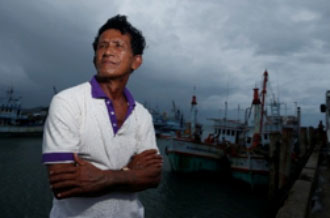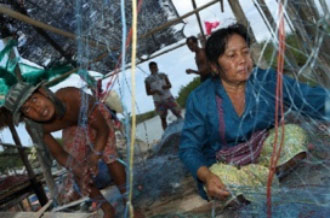In South Thailand: No fish, no future
Climate change and destructive fishing methods harm the ecosystem and the lives of fishermen.

Bangkok, Thailand – Strung along the coast of southern Thailand is a line of small fishing towns, nestled between the rugged beauty of the Tanaosri Mountains and the once-abundant waters of the Gulf of Thailand. For centuries, the people of Prachuabkirikhan [“the city in the mountains”] have enjoyed a simple lifestyle of hard work, living from the riches of the ocean and their farmlands.
But this idyllic existence – which attracts tourists looking for a laid-back beach holiday far from the bars and nightclubs of the big resort towns – may soon vanish as the province is hammered on two fronts, by climate change and rampant overfishing.
Keep reading
list of 4 itemsAfter the Hurricane
World’s coral reefs face global bleaching crisis
Why is Germany maintaining economic ties with China?
The times are changing too fast for Niwat Chaloemwong, and he fears for the future of his community. To say that fishing is encoded in his DNA would be trite; Chaloemwong joined the crew of a small local fishing boat at the age of 12 and spent the next 40 years supporting his family from the ocean.
“When I started fishing, there were so many sharks and stingrays in this bay. There were many kinds of fish that we used to catch, but now we don’t see them at all any more.” He traces the dramatic drop in the catch by ordinary fishermen to the proliferation of commercial trawlers in the Gulf.
“I first saw those trawlers come to this bay about 20 years ago. When they come, they dredge everything away; even the fish spawn, because the mesh they use is so fine. This is dangerous because it means the fish can’t breed and can become extinct.”
 |
| Niwat Chaloemwong says trawlers are destroying the seabed [Roengrit Kongmueng/Greenpeace] |
Trawlers – fishing boats that pull huge nets through the water, sometimes dragging the nets across the sea floor – make up just 13 percent of the fishing vessels in Thailand, but are responsible for more than half of the country’s catch.
“For some small fishermen, the catch has dropped by half. I think this is because the trawlers take too many fish and don’t leave enough for the community,” says Chaloemwong.
Debt is a constant worry for artisan fishermen, for whom a storm or a bad season can spell financial disaster. Angsada Klanphaitoon, a small-scale fisherman from Khao Deng, says the commercial trawlers that flock the Gulf have made their lives even harder.
“These ships have big nets that drag along the sea bed and take everything,” he told Al Jazeera. “They even take the baby fish, which means there is less for us to catch, as they are taking the next generation.”
Not only do the trawlers indiscriminately suck marine life out of the ocean, they can also drag away the nets put out by small fishermen. “Last year it cost me 15,000 Thai baht ($480) to replace my nets after they got caught up by the trawl nets,” said Klanphaitoon. “This is the third time this has happened to me.”
The only way for him to replace the nets is by getting a loan. If the nets vanish again before he has paid off the loan, he is in danger of spiralling into debt he cannot get out of, particularly as there is no guarantee he will get good catches.
Ecosystem destruction
“We go out for squid at night, but my father says there is a lot less to catch than in his day,” said Klanphaitoon. “The shrimp farms release polluted water into the sea and this drives the squid away.”
The shoreline is dotted with shrimp farms, many owned by a massive Thai supermarket chain, feeding the demand for shrimp both locally and abroad. Many rice paddies have been converted into shrimp farms, and the mangroves – which are vital for the coastal ecosystem – have been destroyed, reportedly by effluent from the farms, which includes antibiotics and fertiliser.
Angsada’s mother, Thongpoon Klanphaitoon, says the loss of the mangroves also creates a physical danger. “I notice that the weather is less predictable than when I was young, and the storms are bigger and come more often,” she said. “If the storm comes from the west, where we still have our mangroves, then it won’t be so bad. But on our northeast side, the owner of the shrimp farm has removed the mangrove, so when the storm comes from that direction it hits us very hard.”
 |
| Thongpoon Klanphaitoon and her son Angsada check nets in Khao Deng [Roengrit Kongmueng/Greenpeace] |
Chaloemwong points out that many fishing families have had to adapt to the declining catch by modifying their small boats and focusing on catching squid and crabs.
“They just can’t catch enough other kinds of fish anymore. If this continues, everybody will be in trouble in this community.”
He is also deeply worried about how he has seen the climate change during his own lifetime.
“In the past, the seasons were well-defined, but now there is no winter and the summers are even hotter,” he noted. Chaloemwong’s sister is a pineapple farmer – one of the staple crops of the area – and he says his family has noticed that the heat is making it harder for people to work long hours during the day.
“Now the children are getting sick from the heat, the adults are getting tired more quickly and people have to shower three times a day, just to keep going.”
The impact of global warming on the oceans is more obvious to him, a change that has happened rapidly and recently. “We have noticed that the seawater is getting much warmer,” he said. “When the water is hot, all the decaying matter on the ocean floor floats to the surface and creates a bloom of algae. This blocks the oxygen from the water and the fish can’t breathe any more, because the water is rotten. That algae is very slimy and it coats our nets, so when we try pull them in, they slip out of our hands.”
While Chaloemwong’s seafaring trips are over, he is still an integral part of the fishing community and shares their worries for the future. “Many fishermen have already had to quit because they have to take loans to pay for boats and equipment, but then when they can’t catch enough fish, they can’t repay the loans and they have to sell their boats.”
When I was young, we took only what we needed. The problem is that now there is no more balance between humans and nature.
With both agriculture and fishing under threat, he is uncertain about how the community will survive. The one thing he is sure of is that humans are at the heart of these problems: “When I was young, we took only what we needed. The problem is that now there is no more balance between humans and nature.”
At a nearby pier, fleets of bottom-trawlers disgorge their catch. Men in plastic boots and cowboy hats quickly sort the haul, separating the fish to be packed on ice and sold to big processing companies from the discarded bycatch and so-called “trash fish”. These trash fish make up as much as 60 percent of the trawlers’ catch, and about 30 percent of these trash fish are juveniles.
The bycatch is particularly poignant; stingrays and sharks flapping across the deck, masses of juvenile fish and fish roe entangled in the mesh of the weighted nets. These fish aren’t the intended target of the trawlers, but are dragged aboard in the nets anyway. Trash fish are those that can’t be sold for food, so are destined to be mashed into a fish pulp, dried and turned into pellets to feed farmed prawns.
The quay is slick with a mosaic of tiny discarded fish, a grim reminder of the toll these trawlers are extracting, not just on the oceans but on the lives of fishing communities. After the refrigerated trucks have been loaded, a crew member turns a high-pressure hose onto the deck and nets, blasting away any small fish that remain, and with them a vital part of the ocean life cycle.
Follow Nicole Johnston on Twitter: @NicoleJohnston